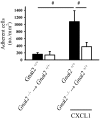Galphai2 is required for chemokine-induced neutrophil arrest
- PMID: 17699741
- PMCID: PMC2077322
- DOI: 10.1182/blood-2007-06-094565
Galphai2 is required for chemokine-induced neutrophil arrest
Abstract
Chemokines, including CXCL1, participate in neutrophil recruitment by triggering the activation of integrins, which leads to arrest from rolling. The downstream signaling pathways which lead to integrin activation and neutophil arrest following G-protein-coupled receptor engagement are incompletely understood. To test whether Galpha(i2) is involved, mouse neutrophils in their native whole blood were investigated in mouse cremaster postcapillary venules and in flow chambers coated with P-selectin, ICAM-1, and CXCL1. Gnai2(-/-) neutrophils showed significantly reduced CXCL1-induced arrest in vitro and in vivo. Similar results were obtained with leukotriene B(4) (LTB(4)). Lethally irradiated mice reconstituted with Gnai2(-/-) bone marrow showed a similar defect in chemoattractant-induced arrest as that of Gnai2(-/-) mice. In thioglycollate-induced peritonitis and lipopolysaccaride (LPS)-induced lung inflammation, chimeric mice lacking Galpha(i2) in hematopoietic cells showed about 50% reduced neutrophil recruitment similar to that seen in Gnai2(-/-) mice. These data show that neutrophil Galpha(i2) is necessary for chemokine-induced arrest, which is relevant for neutrophil recruitment to sites of acute inflammation.
Figures





Similar articles
-
Protein kinase C-θ is required for murine neutrophil recruitment and adhesion strengthening under flow.J Immunol. 2012 Apr 15;188(8):4043-51. doi: 10.4049/jimmunol.1101651. Epub 2012 Mar 7. J Immunol. 2012. PMID: 22403440
-
Gαi2 is the essential Gαi protein in immune complex-induced lung disease.J Immunol. 2013 Jan 1;190(1):324-33. doi: 10.4049/jimmunol.1201398. Epub 2012 Dec 5. J Immunol. 2013. PMID: 23225882
-
Defective macrophage migration in Gαi2- but not Gαi3-deficient mice.J Immunol. 2012 Jul 15;189(2):980-7. doi: 10.4049/jimmunol.1200891. Epub 2012 Jun 15. J Immunol. 2012. PMID: 22706085
-
Gnb isoforms control a signaling pathway comprising Rac1, Plcβ2, and Plcβ3 leading to LFA-1 activation and neutrophil arrest in vivo.Blood. 2016 Jan 21;127(3):314-24. doi: 10.1182/blood-2015-06-651034. Epub 2015 Oct 14. Blood. 2016. PMID: 26468229 Free PMC article.
-
Arrest chemokines.Microcirculation. 2003 Jun;10(3-4):289-95. doi: 10.1038/sj.mn.7800194. Microcirculation. 2003. PMID: 12851646 Review.
Cited by
-
Alveolar epithelial and vascular CXCR2 mediates transcytosis of CXCL1 in inflamed lungs.Nat Commun. 2025 May 24;16(1):4846. doi: 10.1038/s41467-025-60174-w. Nat Commun. 2025. PMID: 40413164 Free PMC article.
-
The role for decorin in delayed-type hypersensitivity.J Immunol. 2011 Dec 1;187(11):6108-19. doi: 10.4049/jimmunol.1100373. Epub 2011 Oct 31. J Immunol. 2011. PMID: 22043007 Free PMC article.
-
Plasma Exosomal-Derived SERPINA1 and GNAI2 Downregulation as Potential Diagnostic Biomarkers of Kawasaki Disease with Coronary Artery Aneurysms.Int J Mol Sci. 2025 Mar 16;26(6):2668. doi: 10.3390/ijms26062668. Int J Mol Sci. 2025. PMID: 40141310 Free PMC article.
-
Acute loss of renal function attenuates slow leukocyte rolling and transmigration by interfering with intracellular signaling.Kidney Int. 2011 Sep;80(5):493-503. doi: 10.1038/ki.2011.125. Epub 2011 May 11. Kidney Int. 2011. PMID: 21562471 Free PMC article.
-
Csk-mediated Src family kinase regulation dampens neutrophil infiltration during pulmonary infection.JCI Insight. 2025 Jun 10;10(14):e188323. doi: 10.1172/jci.insight.188323. eCollection 2025 Jul 22. JCI Insight. 2025. PMID: 40493407 Free PMC article.
References
-
- Butcher EC. Leukocyte-endothelial cell recognition: three (or more) steps to specificity and diversity. Cell. 1991;67:1033–1036. - PubMed
-
- Springer TA. Traffic signals for lymphocyte recirculation and leukocyte emigration: the multistep paradigm. Cell. 1994;76:301–314. - PubMed
-
- Ley K. Integration of inflammatory signals by rolling neutrophils. Immunol Rev. 2002;186:8–18. - PubMed
-
- Salas A, Shimaoka M, Kogan AN, Harwood C, von Andrian UH, Springer TA. Rolling adhesion through an extended conformation of integrin alphaLbeta2 and relation to alpha I and beta I-like domain interaction. Immunity. 2004;20:393–406. - PubMed
Publication types
MeSH terms
Substances
Grants and funding
LinkOut - more resources
Full Text Sources
Molecular Biology Databases
Miscellaneous

